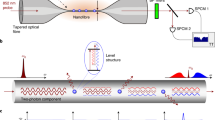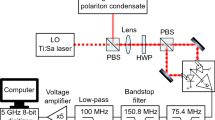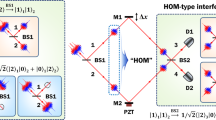Abstract
At optical frequencies the radiation produced by a source, such as a laser, a black body or a single-photon emitter, is frequently characterized by analysing the temporal correlations of emitted photons using single-photon counters. At microwave frequencies, however, there are no efficient single-photon counters yet. Instead, well-developed linear amplifiers allow for efficient measurement of the amplitude of an electromagnetic field. Here, we demonstrate first- and second-order correlation function measurements of a pulsed microwave-frequency single-photon source integrated on the same chip with a 50/50 beam splitter followed by linear amplifiers and quadrature amplitude detectors. We clearly observe single-photon coherence in first-order and photon antibunching in second-order correlation function measurements of the propagating fields.
This is a preview of subscription content, access via your institution
Access options
Subscribe to this journal
Receive 12 print issues and online access
$209.00 per year
only $17.42 per issue
Buy this article
- Purchase on Springer Link
- Instant access to full article PDF
Prices may be subject to local taxes which are calculated during checkout



Similar content being viewed by others
References
Walls, D. & Milburn, G. Quantum Optics (Spinger, 1994).
Caves, C. M. Quantum limits on noise in linear amplifiers. Phys. Rev. D 26, 1817–1839 (1982).
Houck, A. et al. Generating single microwave photons in a circuit. Nature 449, 328–331 (2007).
Pozar, D. M. Microwave Engineering (Addison-Wesley, 1993).
Gabelli, J. et al. Hanbury Brown–Twiss correlations to probe the population statistics of GHz photons emitted by conductors. Phys. Rev. Lett. 93, 056801 (2004).
Mariantoni, M. et al. Planck spectroscopy and quantum noise of microwave beam splitters. Phys. Rev. Lett. 105, 133601 (2010).
Menzel, E. P. et al. Dual-path state reconstruction scheme for propagating quantum microwaves and detector noise tomography. Phys. Rev. Lett. 105, 100401 (2010).
Koch, J. et al. Charge-insensitive qubit design derived from the Cooper pair box. Phys. Rev. A 76, 042319 (2007).
Wallraff, A. et al. Strong coupling of a single photon to a superconducting qubit using circuit quantum electrodynamics. Nature 431, 162–167 (2004).
Bianchetti, R. et al. Dynamics of dispersive single-qubit readout in circuit quantum electrodynamics. Phys. Rev. A 80, 043840 (2009).
Hofheinz, M. et al. Synthesizing arbitrary quantum states in a superconducting resonator. Nature 459, 546–549 (2009).
Deleglise, S. et al. Reconstruction of non-classical cavity field states with snapshots of their decoherence. Nature 455, 510–514 (2008).
Mandel, L. & Wolf, E. Optical Coherence and Quantum Optics (Cambridge Univ. Press, 1995).
da Silva, M. P., Bozyigit, D., Wallraff, A. & Blais, A. Schemes for the observation of photon correlation functions in circuit QED with linear detectors. Phys. Rev. A 82, 043804 (2010).
Gardiner, C. W. & Collett, M. J. Input and output in damped quantum systems: Quantum stochastic differential equations and the master equation. Phys. Rev. A 31, 3761–3774 (1985).
Grosse, N. B., Symul, T., Stobinska, M., Ralph, T. C. & Lam, P. K. Measuring photon antibunching from continuous variable sideband squeezing. Phys. Rev. Lett. 98, 153603 (2007).
Kimble, H. J., Dagenais, M. & Mandel, L. Photon antibunching in resonance fluorescence. Phys. Rev. Lett. 39, 691–695 (1977).
Kuhn, A., Hennrich, M. & Rempe, G. Deterministic single-photon source for distributed quantum networking. Phys. Rev. Lett. 89, 067901 (2002).
Diedrich, F. & Walther, H. Nonclassical radiation of a single stored ion. Phys. Rev. Lett. 58, 203–206 (1987).
Basché, T., Moerner, W. E., Orrit, M. & Talon, H. Photon antibunching in the fluorescence of a single dye molecule trapped in a solid. Phys. Rev. Lett. 69, 1516–1519 (1992).
Michler, P. et al. A quantum dot single-photon turnstile device. Science 290, 2282–2285 (2000).
Kurtsiefer, C., Mayer, S., Zarda, P. & Weinfurter, H. Stable solid-state source of single photons. Phys. Rev. Lett. 85, 290–293 (2000).
Castellanos-Beltran, M. A., Irwin, K. D., Hilton, G. C., Vale, L. R. & Lehnert, K. W. Amplification and squeezing of quantum noise with a tunable Josephson metamaterial. Nature Phys. 4, 929–931 (2008).
Acknowledgements
We thank T. Frey and G. Littich for their contributions at the early stages of the project. We also thank C. M. Caves, D. Esteve and especially K. W. Lehnert for very fruitful discussions and J. Blatter for comments on the manuscript. This work was supported by the European Research Council (ERC) through a Starting Grant and by ETHZ. M.P.d.S. was supported by a NSERC postdoctoral fellowship. A.B. was supported by NSERC, CIFAR and the Alfred P. Sloan Foundation.
Author information
Authors and Affiliations
Contributions
D.B., C.L. and L.S. carried out the experiments. D.B. and C.L. analysed the data and developed hardware data processing. J.M.F. and L.S. designed and fabricated the sample. Experiments were carried out at ETH Zurich; all authors in Zurich contributed to setting up and maintaining the cryogenic set-up, and developing measurement software. M.P.d.S. and A.B. contributed to the theoretical interpretation. A.W. and D.B. wrote the manuscript. All authors commented on the manuscript. A.W. supervised the project.
Corresponding author
Ethics declarations
Competing interests
The authors declare no competing financial interests.
Rights and permissions
About this article
Cite this article
Bozyigit, D., Lang, C., Steffen, L. et al. Antibunching of microwave-frequency photons observed in correlation measurements using linear detectors. Nature Phys 7, 154–158 (2011). https://doi.org/10.1038/nphys1845
Received:
Accepted:
Published:
Issue Date:
DOI: https://doi.org/10.1038/nphys1845
This article is cited by
-
Heterodyne sensing of microwaves with a quantum sensor
Nature Communications (2021)
-
Amplitude and frequency sensing of microwave fields with a superconducting transmon qudit
npj Quantum Information (2020)
-
Electric field correlation measurements on the electromagnetic vacuum state
Nature (2019)
-
Photodetection probability in quantum systems with arbitrarily strong light-matter interaction
Scientific Reports (2018)
-
Deterministic quantum state transfer and remote entanglement using microwave photons
Nature (2018)



